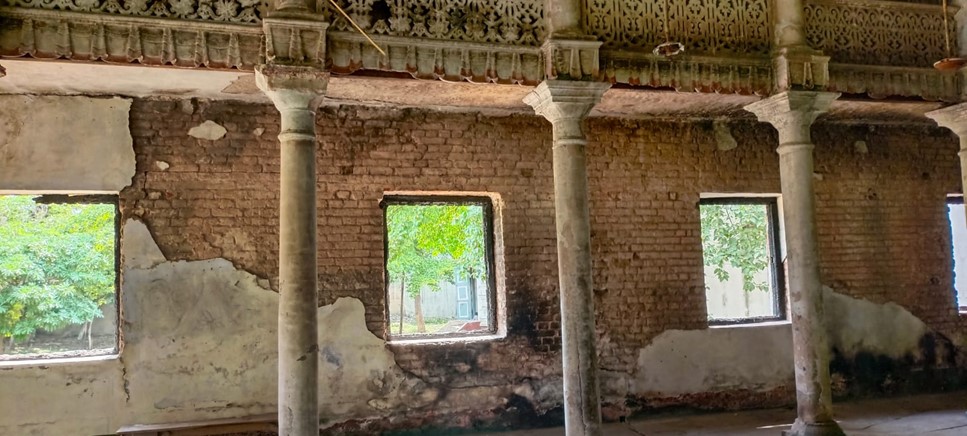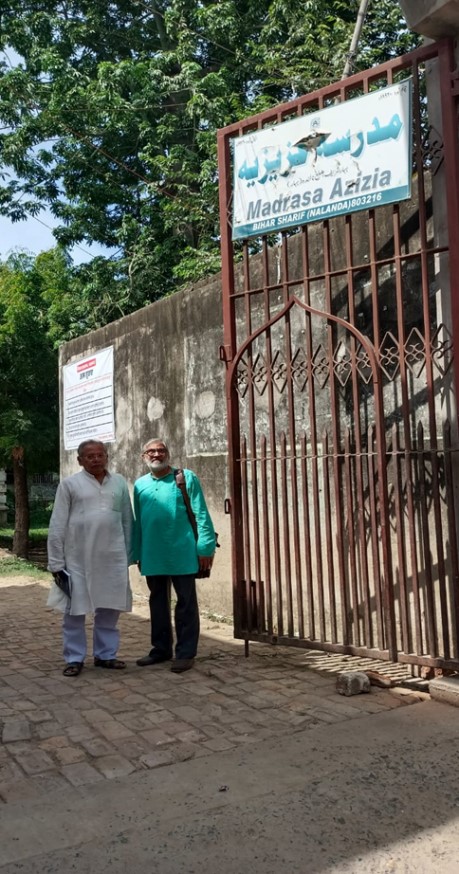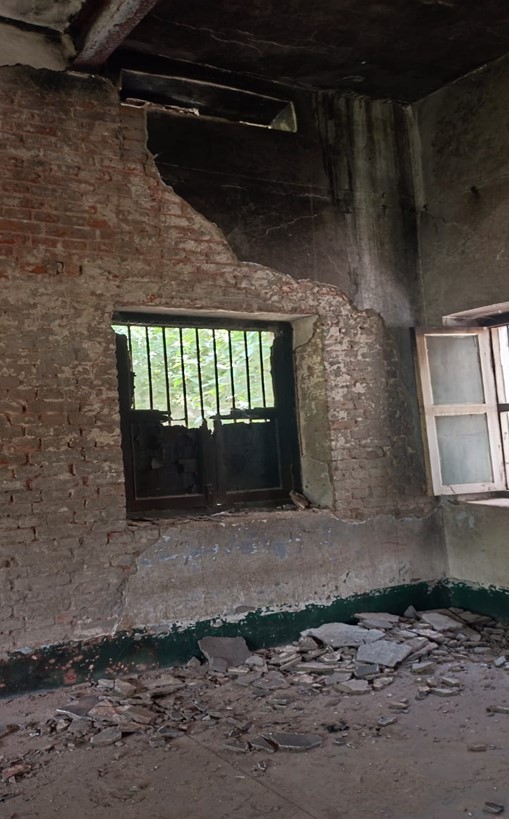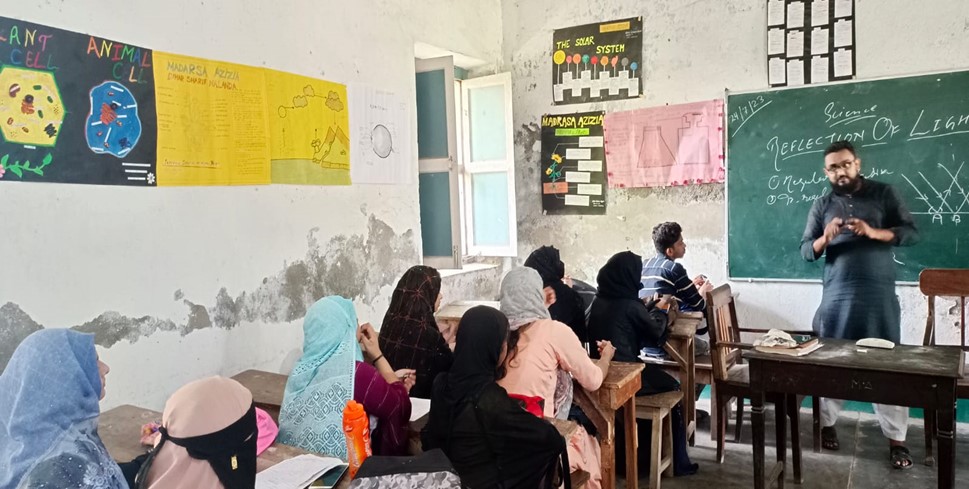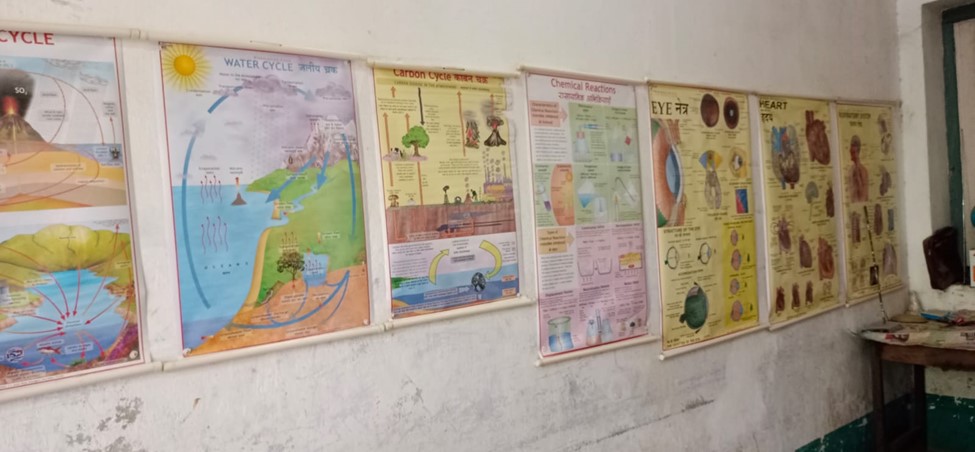The Shobha Yatra witnessed 50,000 strong procession that had come together to celebrate Ram Navami one day after Ram Navami. A section of the procession went on a rampage- vandalizing, looting and setting properties owned by Muslims on fire. Some members of the procession approached Muslim men in Gagan Diwan locality and forced them to say ‘Jai Shri Ram’. This demand was coupled with attacks with sticks and swords on the Muslim men. The communal riot that went on for over two days witnessed massive losses- properties worth crores of rupees, almost all belonging to Muslims, two lives lost and some severely injured. Amongst the properties destroyed were the Shahi Masjid in Murarpur, Badi Masjid, Asia Hotel, City Palace Banquet Hall, Digital Duniya and Azizia Madrasa and Library. In the face of disturbing news reported in the media and the emerging pattern of violence on the occasion of Ram Navami from different parts of the country, a fact-finding team led by Centre for Study of Society and Secularism (CSSS) visited Bihar Sharif on 23rd and 24th July. The team visited the affected areas and met different stakeholders in this conflict.
Why is it important to discuss and reflect back on the destruction of the Azizia Madrasa in particular? The Azizia Madrasa is significant in more than one ways. It was a heritage site established in 1910, making it over 110 years old. It holds special salience as it is an important and prestigious centre of learning and education for the Muslim community. The Azizia Madrasa is located over a sprawling three-acre campus. The library of the Madrasa, which had over 4500 books, 250 of them being rare manuscripts which were hand written, was completely gutted in the fire started by a mob comprising over 150 persons who attacked the Madrasa between 5.30pm and 6pm on 31st March, 2023.
It is imperative and fairly instructive to understand the scale of the damage in the Madrasa which will help reflect on important questions. How was such a massive structure set on fire? Why was this Madrasa targeted in the first place? The Madrasa had a beautiful two storied library and Hall, several classrooms, a computer lab and hostels for the students to reside. The haunting site that the fact-finding team was greeted with, when it visited the Madrasa, was a ruined large hall which was once opulent. The large hall had majestic pillars covered in black soot as was the high roof. The hall had a graceful mezzanine floor which had books and answer sheets in the almirahs. The hall had 10 ceiling fans which were warped from the flames of the fire. The mangled furniture was stacked hopelessly in one of the corners of the hall. The total height of the grand hall and the mezzanine library is about 20 feet giving it an appearance of aesthetic grandeur.
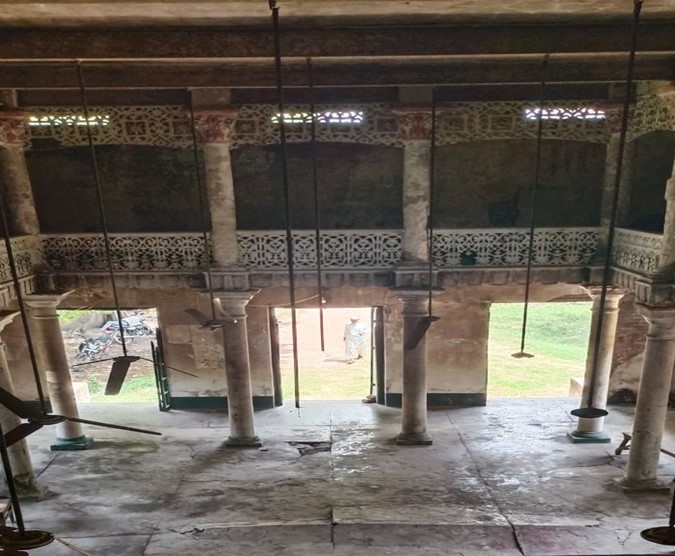
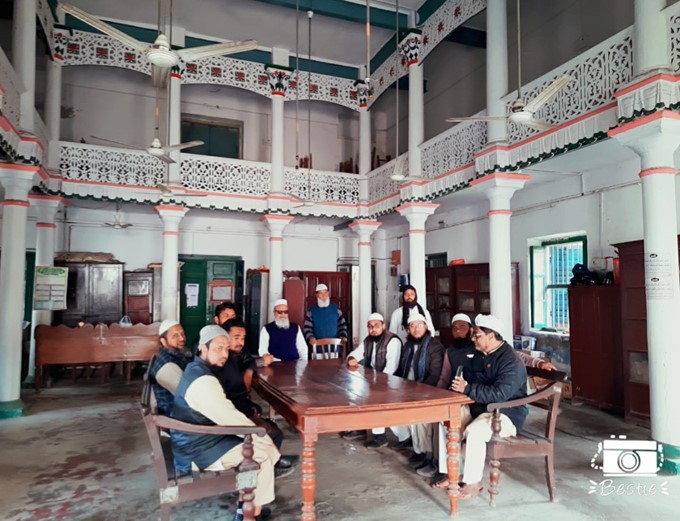
What did it take to burn down the hall and Library of this scale? Petrol bombs were used to set the madrasa on fire. It is quite obvious that to burn down the hall and library of this size it would take substantial quantity of petrol. How was such large quantity of petrol transported? Surely this is not a spontaneous act. Petrol bombs were planted outside each classroom and the authors saw the signs of soot on the doors of the classrooms. The water pipes in the Madrasa too were cut deliberately so that the fire can’t be put off. The CCTVs were completely burnt. So extensive was the damage that the corridor was filled with a layer of 6 inches of ashes. The roof of the corridors was still black from the soot when the fact-finding team visited the Madrasa. The Library of the Madrasa had 4500 books of philosophy, science, Islamic jurisprudence etc. It included 250 rare books which were handwritten manuscripts and were of great value. It took a ditch four feet deep and 10 feet wide to bury the ashes of these burnt books. One can gauge the intensity of the fire from the uprooted floor in the Hall. The office of the Madrasa was completely burnt and the staff didn’t even have a single chair or table to use. All the valuable records were burnt.
The petrol bombs used to burn the Madrasa and the extent of damage point towards the planned nature of attack. The persistent attempt to destroy the Madrasa also is a testimony to the same. While the Madrasa was attacked on 31st March, it was also attacked again on 1st April when a mob came from the back of the complex. It is noteworthy that the administration had imposed a curfew on 31st March and 1st April. Ironically, despite the curfew, the Madrasa was attacked again on 1st April when some miscreants entered the Madrasa from the back and tried to ignite a kerosene stove under a wooden cot. The Hindu Nepali watchman of the Madrasa was beaten up by the mob when he tried to stop them. He was let go when he told them he was a Hindu. This selected targeting of the Madrasa gives away the intention behind the attack. Similar attempts to attack the Madrasa were made in 1981 and 2017 when communal violence engulfed the city.
This draws the focus to the important question that why is the Madrasa a constant target of attacks? The answer is that the Madrasa which symbolizes Muslim culture and knowledge, is attacked with a communal agenda to demonstrate hegemony of the Hindu right wing. As opposed to the popular perception shaped predominantly by communal narratives, the Azizia madrasa is no den of terrorism but recognized as a model madrasa by the state. The Madrasa has been the Markaaz for four surrounding districts. There are programmes run by the Madrasa to spread awareness amongst the students and teachers about the inter-religious approach. It has been recognized by UNESCO for its rich heritage and finds mention by United Nations Population Fund (UNFPA). However, the Hindu right wing targeted the Madrasa in a bid to avenge the alleged burning down of the Nalanda University by Bakhtiyar Khilji in 1197. This is an oft repeated narrative by the right wing in the region of Bihar Sharif. That Azizia Madrasa is prestigious centre of learning, knowledge and religion contributed to it being a target of vicious attack. This attack which has cost invaluable rare manuscripts and other cultural infrastructure has demoralized the Muslim community and expose its vulnerability in the face of violent ideology that hugely influences the response of the state to such threats of destruction and intimidation.
What struck the fact-finding team when it visited the Madrasa was the teacher was teaching a science lesson on the topic of light in English to a classroom full of girl students. The Madrasa is school to over 500 students, 85% of them girls from first grade to twelfth grade. The Madrasa is salient also because of the number of Muslim girls studying in it. It is generally observed that after communal violence, the mobility and exposure of girls from marginalized communities including to schools is usually restricted out of concerns of safety. However, it was heartening to witness the faith the parents of the girls have reposed in the management of the Madrasa and are sending their daughters back to school which is still in the process of being repaired even after four months of the attack. The team also saw the computer room in the Madrasa and a science lab full of charts of human anatomy and other science topics. Thus, the Madrasa was not an obscure institution catering to only few Muslim students teaching Islam and religious tenets but a centre for education of modern relevant subjects.
That the Madrasa has contributed meaningfully to society and Muslim intelligentsia is evident from the illustrious alumni the Madrasa boasts of. Some of the alumni included Maulana Abu Salma, who retired as Principal of Madrasa in Agra, Maulana Masood Ali Nadwi, prominent author and writer and Mufti Nizamuddin who retired as Mufti Azam (grand Mufti) in Darul Deoband. Darul Deoband is the prestigious institution for learning of Islam and philosophy. Other alumni include Maulana Abdul Rehman who was the 5th Amir-e- Shariat (Custodian of Islamic jurisprudence), Maulana Shabnam Kalami, renowned poet who is recipient of various awards from the state and his poetry has been included in Bihar Board syllabus. The alumni also include Dr. M. M Kamal, who retired as Registrar of Veer Kanwar Singh University. These alumni have thus contributed in the sphere of education, religion, culture and literature. Established in 1896 in Patna and later shifted in 1910 to in Bihar Sharif, a historic city in the Nalanda district of Bihar, Madrasa Azizia was built by the philanthropist Bibi Soghra in memory of her husband, Abdul Aziz. Soghra inherited property worth lakhs after her husband’s death and decided to donate it. The Azizia Madrasa was built by Bibi Soghra’s donations. Others include Soghra High School and Soghra College. They are still managed by Soghra Waqf Estate.
The Madrasa symbolized not just knowledge but cultural heritage and social cohesion. The Madrasa has existed for over a century and stands testament to the cordial and peaceful relations between Hindu and Muslims in Bihar Sharif and beyond in the state of Bihar. The team was informed that the relationship between the Madrasa management and the Hindu neighbours have been marked by respect and cooperation. Madrasa thus posed no threat to state or society. The relations with Hindu neighbours have been cordial and friendly and there is heathy socialization. In fact, fifty percent shops in the Madrasa complex which are about 40 shops are allotted to Hindus.
Despite the centrality and importance of scale that the Azizia embodies, the state and the media didn’t do it any justice. The state’s response has been tardy and inadequate, bordering complicity when the Madrasa was set on fire along with other parts of Bihar Sharif. The fire brigade reached the Madrasa only after midnight though the fire began at around 5.30 pm. The administration was not prompt in responding to the pleas of help from the Imam or other staff of the Madrasa. However, ironically, the administration promptly cleared up the debris and ashes in the property in the wee hours of 1st April. It appeared like the administration wanted to clear away evidence. The state which surveyed the extensive damage of the Madrasa to the tune of INR 3.42 crores including furniture, almirahs, computers etc. has not released any compensation amount. The state has so far only installed a barbed wire fencing around the Madrasa. The media too didn’t give the kind of coverage the Madrasa of the significance it is deserves. The local and national media trivialized the fire and the damages and it took international media including the BBC to report the extent of damage and severity of the attack on the Madrasa
The management of the Madrasa too pointed out that the Madrasa was targeted for the cultural resources it possessed. The Hindutva narrative that the Nalanda University was destroyed by Bakhtiyar Khilji and that act should be avenged by destroying the Madrasa has been oft repeated. Nalanda University was a giant institution and a great centre of Buddhist learning, philosophy, maths, science. It was at one point headed by the iconic mathematician Aryabhatta. It had students from Korea, China, Turkey and other Eastern and Central parts of Asia studying in the University. The library of Nalanda University was home to massive collection of rare books and wealth of knowledge.
It is not known widely that the attack by Khilji on Nalanda University was not the first time Nalanda University was attacked. It was attacked by the Huns under Mihirkula in the 5th Century, and again sustained severe damages from an invasion of the Gauda king of Bengal, in the 8th Century. Huns came to plunder. The attack by the King of Bengal was the result of a growing antagonism between their Shaivite Hindu sect and the Buddhists at the time. There is no single widely accepted historical reason as to why the University was attacked by Khilji. One of the reasons cited which seems implausible claims that Khilji burnt down the University out of spite after Rahul Shribhadra cured him when the doctors in his own court were unable to. In a fit of rage, Khilji wanted to destroy this centre of knowledge. It is worth noting that when Khilji attacked Nalanda it was already on a decline and ascending into ruins due to violence arising from the rivalry between Hinayana and Mahayana Buddhist sects or their influence by Brahminism. However there is no consensus on any one theory by the historians.
The question, after witnessing this senseless destruction of heritage and centre for learning, that confronts us as civilized society is whether revenge is good enough motivation for burning down an institution like Azizia? Did we want Azizia Madrasa or should we want Azizia Madrasa to go down in history with the same fate as Nalanda University? Should we become another Khilji even if we believe that Khilji burned down Nalanda? Should centres signifying reason, knowledge, culture and social harmony be allowed to be engulfed in flames of hatred and communal venom? And should we be mute spectators to this dance of violence and destruction? If razing down Nalanda University was wrong then burning down Azizia was equally wrong. It is time we judge violence from the lens of justice and not revenge. The focus should shift from destruction to dialogue, from vengeance to understanding. The burning of Azizia Madrasa signifies a larger struggle between preserving cultural heritage, nurturing interfaith harmony, and confronting the destructive force of violence. Beyond the immediate destruction, the incident compels us to address these issues with urgency and empathy before the flames of hatred engulf humanity and knowledge.
Related:
‘Books now, humans later’: An ominous warning for the nation
